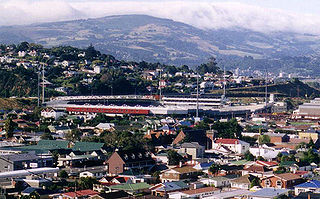
Craven Cottage is a football stadium located in Fulham, London. It has been the home ground of Fulham F.C. since 1896. The ground's current capacity is 25,700, all-seated, though the record attendance is 49,335, for a game against Millwall, 8 October 1938. Located next to Bishop's Park on the banks of the River Thames, 'Craven Cottage' was originally a royal hunting lodge and has history dating back over 300 years.

Taunton is a large regional town in Somerset, England. The town's population in 2011 was 69,570. Taunton has over 1,000 years of religious and military history, including a 10th century monastery and Taunton Castle, which has origins in the Anglo Saxon period and was later the site of a priory. The Normans then built a stone structured castle, which belonged to the Bishops of Winchester. The current heavily reconstructed buildings are the inner ward, which now houses the Museum of Somerset and the Somerset Military Museum.

Croke Park is a Gaelic Athletic Association stadium located in Dublin, Ireland. Named in honour of Archbishop Thomas Croke, it is often called Croker by some GAA fans and locals. It serves both as the principal stadium and headquarters of the Gaelic Athletic Association (GAA).

The Lansdowne Road Stadium was a stadium in Dublin owned by the Irish Rugby Football Union (IRFU) that was primarily for used rugby union and association football matches. The stadium was demolished in 2007 to make way for the construction of the Aviva Stadium, which opened in 2010.

Goodison Park is a football stadium in Walton, Liverpool, England that has been home to Premier League club Everton since its completion in 1892. The stadium is in a residential area two miles (3 km) from Liverpool city centre. It has an all-seated capacity of 39,572.

Páirc Uí Chaoimh is a Gaelic games stadium in Cork, Ireland. It is the home of Cork GAA. The venue, often referred to simply as The Park, is located in Ballintemple and is built near to the site of the original Cork Athletic Grounds. The stadium opened in 1976 and underwent a significant two-year redevelopment before reopening in 2017.

Carisbrook was a major sporting venue in Dunedin, New Zealand. The city's main domestic and international rugby union venue, it was also used for other sports such as cricket, football, rugby league and motocross. Carisbrook also hosted a Joe Cocker concert and frequently hosted pre-game concerts before rugby matches in the 1990s. In 2011 Carisbrook was closed, and was replaced as a rugby ground by Forsyth Barr Stadium at University Plaza in North Dunedin, and as a cricket ground by University Oval in Logan Park.

The Brisbane Cricket Ground, commonly known as the Gabba, is a major sports stadium in Brisbane, the capital of Queensland, Australia. The nickname Gabba derives from the suburb of Woolloongabba, in which it is located.

Headingley Stadium in Headingley, Leeds, West Yorkshire, England, is the home of Yorkshire County Cricket Club and Leeds Rhinos rugby league and Yorkshire Carnegie rugby union clubs.

The India women's national cricket team, nicknamed the Women in Blue, represents the country of India in international women's cricket. One of eight teams competing in the ICC Women's Championship, the highest level of international women's cricket, the team is governed by the Board of Control for Cricket in India (BCCI).

The 2011 ICC Cricket World Cup was the tenth Cricket World Cup. It was played in India, Sri Lanka, and Bangladesh. India won the tournament, defeating Sri Lanka by 6 wickets in the final at Wankhede Stadium in Mumbai, thus becoming the first country to win the Cricket World Cup final on home soil. India's Yuvraj Singh was declared the man of the tournament. This was the first time in World Cup history that two Asian teams had appeared in the final. It was also the first time since the 1992 World Cup that the final match did not feature Australia.

The Sharjah Cricket Stadium is in Sharjah in the United Arab Emirates. It holds the record for the most number of ODIs hosted in a venue with 236 ODIs up to 19 February 2018. It was originally constructed in the early 1980s and has been much improved over the years. In 2010, at the behest of local cricketing patron Abdul Rahman Bukhatir, the Sharjah Cricket Stadium became the home ground for the Afghanistan cricket team for One Day International and First-Class matches. In 2016, Afghanistan changed their home ground to Greater Noida Sports Complex Ground in Noida, India. The Multan Sultans and the Quetta Gladiators used the Sharjah Cricket Stadium for most of their home games in the most recent PSL season.

Christian Brothers College, Monkstown Park is a private fee-paying Catholic school and Independent Junior school, founded in 1856 in Monkstown, Dún Laoghaire, County Dublin, Ireland. The college arrived at Monkstown Park in 1950 from Eblana Avenue in Dún Laoghaire via a short stint on Tivoli Road. As of September 2018, it will be in its 69th academic year of existence at Monkstown Park, the 162nd overall.

The 2019 Cricket World Cup is the 12th edition of the Cricket World Cup, scheduled to be hosted by England and Wales, from 30 May to 14 July 2019.

A floodlight is a broad-beamed, high-intensity artificial light. They are often used to illuminate outdoor playing fields while an outdoor sports event is being held during low-light conditions. More focused kinds are often used as a stage lighting instrument in live performances such as concerts and plays.



















